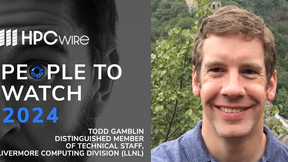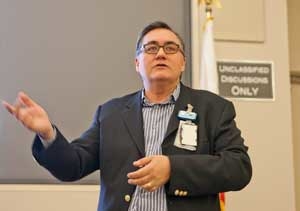Lab delegation explores China's supercomputing power
China's advances in building science and technology infrastructure, especially supercomputing, has been in the news lately. Last week, National Public Radio aired a piece documenting the country's achievements in supercomputing including its six-month reign as the home of the world's fastest supercomputer. As recently as 2001, China did not appear at all on the current Top500 list . According to the current list, China has 61 of the Top500 supercomputing sites in the world, second only to the United States.
And supercomputing is only one of several areas where China is making dramatic progress.
A delegation from the Laboratory, led by Deputy Director Tomas Diaz de la Rubia, reported on a recent trip to China in a special presentation Aug. 3 at the Terascale Simulation Facility. Presenters from the delegation included Diaz de la Rubia, Dona Crawford, the Lab's associate director for Computation; Julio Friedmann, director for the Lab's carbon management program, and Clara Smith, post-doctoral research scientist at the Lab.
"We went to China with the primary purpose of ascertaining the current state of China's supercomputing capability and the application of high-performance computing to research and development," said Diaz de la Rubia.
"Our secondary purpose was to explore China's drive to develop clean energy technologies. We learned China has a staggering rate of growth in science and technology, including high performance computing and research institutes."
He said China appears to be making very large investments in its supercomputing and related research and development. They also appear to be investing heavily in indigenous technology and aggressively recruiting Chinese nationals from around the world, particularly the United States, to return to China after studying abroad. "One of the most striking observations was the extent to which they are starting to apply their supercomputing capability to accelerating the development of strategic industrial technologies such as clean energy and aerospace.
Diaz de la Rubia concluded: "Our decades of investment and development in supercomputing still put us ahead of China today, but we need to ask ourselves if we're moving fast enough to stay ahead."
Chinese supercomputing: low risk, high yield
Crawford said she learned China is taking a balanced, long-term approach to supercomputer development "They don't want to be on the bleeding edge. Rather, they will leverage existing technology, play with big partners and work with users who give them valuable experiences."
China is taking a very practical approach, she said. "They believe that sustainable high performance computing is based on practical applications, not abstract metrics like Linpack, and they understand the tremendous technical challenges and expense of going to exascale."
Crawford believes Chinese computer scientists are interested in the same areas as the United States, including software development, the adaptation of open source software, power efficiency, and industrial applications.
"We learned of ambitious five-year plans to accelerate HPC technology and its broad application," Crawford said.
"It is clear that China is bent on becoming one of our competitors in science and technology. But China's emergence as a player in high performance computing and science and technology also offers opportunities for collaboration and fruitful scientific exchanges," she said.
While in China, the delegation visited four supercomputer sites and two computing technology institutes, including Tianjin (Tianhe-1A), ranked at No. 2 on the Top500 list, and Shenzhen (Dawning Nebulae), ranked No. 4.
Energy: fast pace, high risk
The delegation toured the pebble fuel nuclear reactor in Beijing (HTR-10) and the Institute of Nuclear and New Energy Technology test center, a full-scale testing facility to permit and test components for the 200 megawatt commercial reactor. The test center cost $50 million, roughly one-third of a comparable facility in the West.
The delegation also visited two advanced clean coal facilities: the GreenGen gasification plant in Tianjin and the Shidongkou capture pilot west of Shanghai. Both are notable for the large scale and tremendous speed in design and construction: stunningly, the Shidongkou pilot received government granted permits in only three days.
China has proven it can build a major project in only three months and first-of-a-kind power plants in three years, but this rapid pace incurs some risk. Friedmann said, "China is running very quickly, but that makes them more likely to stumble and when they stumble it will hurt more."
Agreement to develop clean energy technology
The delegation, on behalf of the Lab, signed an agreement with the China Huaneng Group, in part to help enable joint research and development of clean energy technologies under the US-China Clean Energy Research Center (CERC). Under the memorandum of understanding, the Laboratory will create a stronger relationship with Huaneng and both parties will conduct research analysis and data exchange. The two parties will partner on joint research and commercial projects involving carbon capture and sequestration, enhanced oil recovery, shale gas and power engineering.
Contact
Brian D Johnson[email protected]
Tags
HPC, Simulation, and Data ScienceComputing
HPC Innovation Center
Science
Featured Articles









